 |
 |
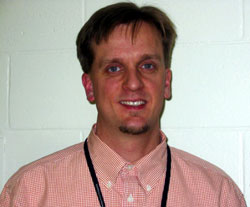
|
|
Don Bliss, M.A., Medical Illustrator, Medical Arts and Photography Branch, Office of Research Services, NIH
|
1. I chose this career because...
2. My typical workday involves...
3. What I like best/least about my work...
4. My career goals are...
5. When I'm not working, I like to...
|
|
1. I chose this career because...
|
Back to Top

|
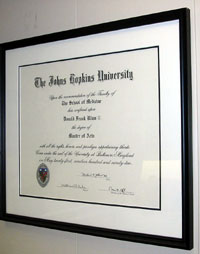
|
|
Don Bliss' Master of Arts degree in Medical and Biological Illustration from Johns Hopkins University School of Medicine
|
I chose to become a medical illustrator, because when growing up, I always loved art. Like every other kid, I drew all the time, but didn’t stop as I grew older. Though I loved drawing, I never considered art as a career. I associated art with painters living in dingy studios barely scraping by. By the time I got to high school, I really liked biology. My biology teacher made learning the structure and mechanisms of life fun. He gave bonus points for the drawings I included in my lab reports, and encouraged me to do better ones.
In college I decided to pursue medicine, and enrolled in a pre-med curriculum. I snuck an art class into each semester just for fun. One afternoon while studying in the biology department, I saw a poster that asked, “What can you do with a biology degree?” A medical illustrator was on the poster’s list. I’d never heard of it before but thought it sounded perfect. I found an old pamphlet from the Association of Medical Illustrators in the campus placement office. I was amazed to discover that medical illustration was the perfect union of the two seemingly unrelated areas I loved.
Education
- B.S., Biology, Southwest Missouri State University
- M.A., Medical and Biological Illustration, Johns Hopkins University School of Medicine
|
|
2. My typical workday involves...
|
Back to Top

|
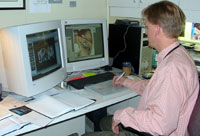
|
|
Don Bliss works views medical illustrations he is working on at his desk.
|
My typical workday involves translating complex science topics and research findings into easy-to-understand illustrations. I meet with doctors and scientists, find out the story they want to tell, and discuss how best to illustrate or animate it. I research the subject I’m working on to understand the concepts.
Understanding the scientific content is what separates medical illustrators from other artists. We want to be able to suggest solutions the scientist hasn’t considered. If I don’t understand the problem, then I create a cleaned-up version of the figure the doctor sketched. If I do understand the problem, I use my artistic training to suggest illustrations that will explain the concepts more clearly.
We start every project with a paper, pencil and a stack of research material. Illustrations or animations are worked through on paper and checked with the scientist for accuracy. We usually use computers to finalize the sketches and add color. Computers are also essential for animation and 3D molecular illustrations.
|
|
3. What I like best/least about my work...
|
Back to Top

|
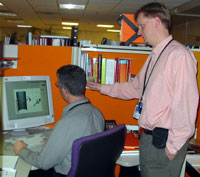
|
|
Don Bliss consults with a collegue in the Medical Arts and Photography Branch.
|
What I like best about my work is the amazing quality and variety of science at the NIH. The doctors I work with are brilliant and inspiring. Our medical arts and printing group consists of creative, intelligent people that I learn from each day. Every project is an opportunity to learn and most of the lessons aren’t in the science books yet. I get a real kick out of helping to explain new science, especially, for example, science that might lead to a vaccine for AIDS or a treatment to destroy tumors.
What I like least about my work is that I don’t have enough time to do everything I want. I’d like to keep up with 3D animation advances, or study more Flash web animation. I’d like to go back to school to study some of the biological fields that have expanded since I graduated. I’d like to sink more time into my favorite projects, but we are simply too busy. There are always more clients lined-up outside the office door.
|
|
4. My career goals are...
|
Back to Top

|
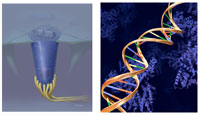
|
|
Two favorite illustrations created by Don Bliss: a hair cell (left) and DNA helix (right).
|
My career goal for the future is to make the NIH Medical Arts and Photography Branch the acknowledged source for medical illustrations and videos for all federal agencies.
|
|
5. When I'm not working, I like to...
|
Back to Top

|
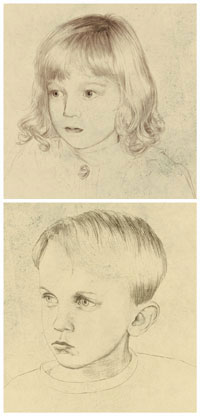
|
|
Don Bliss' sketches of his children.
|
When I’m not working, I love to study fine art. To get a break from the computer, I’m going back to oil painting. I also put on puppet shows with my kids, make up stories for them, or just wrestle with them until they are too wound-up for bed.
|
|
|
|
 |